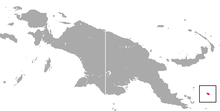Woodlark Cuscus
| Woodlark cuscus | |
|---|---|
| Scientific classification | |
| Kingdom: | Animalia |
| Phylum: | Chordata |
| Class: | Mammalia |
| Order: | Diprotodontia |
| Family: | Phalangeridae |
| Genus: | Phalanger |
| Species: | P. lullulae |
| Binomial name | |
|
Phalanger lullulae Thomas, 1896 |
|
 |
|
| Woodlark cuscus range | |
The Woodlark cuscus (Phalanger lullulae) is a species of marsupial in the family Phalangeridae endemic to Papua New Guinea, specifically on Madau and Woodlark Island, a part of the Milne Bay Province of Papua New Guinea. It happens to be the largest mammal living on Woodlark Island but it is also found on the neighboring island of Alcester, 70 kilometers south of Woodlark Island.
The generic name, Phalanger, is of Greek origin and means "spider's web." This name is given in reference to their syndactyly that exists on their hind feet. Its specific name, lullulae, is Latin in origin and is the Latin translation of "Woodlark."
In a phylogenetic tree published in 1987 by Tim Flannery and his colleagues, Phalanger lullulae was believed to share the same states with Phalanger intercastellanus also known as the Eastern common cuscus. A morphological consensus tree shows that the Phalanger lullulae is related to the Mountain cuscus (Phalanger carmelatie), Phalanger interpositus, Stein's cuscus (Phalanger vestitus), and the Banggai cuscus (Strigocuscus pelengensis). This phylogenetic tree was created by Tim Flannery and his colleagues in 1987 but was also reanalyzed by Ruedas and Morales in 2005. A partial 12S rRNA ML tree by Ruedas and Morales demonstrated the firstly mentioned relationship between the Phalanger lullulae and Phalanger intercastellanus. The Partial 12S rRNA ML tree by Hamilton and Springer demonstrated that the Phalanger lullulae is most closely related to the Northern common cuscus (Phalanger orientalis). An ML tree of the nuclear gene BRCA1 created by Raterman and his colleagues shows the Phalanger lullulae's close relationship to the Phalanger orientalis as well. While these aforementioned phylogenies are more certain, there is another proposed morphological phylogeny by Flannery that demonstrates the uncertainty of the Phalanger lullulae's relationship among the Phalanger orientalis and Phalanger vestitus.
...
Wikipedia

